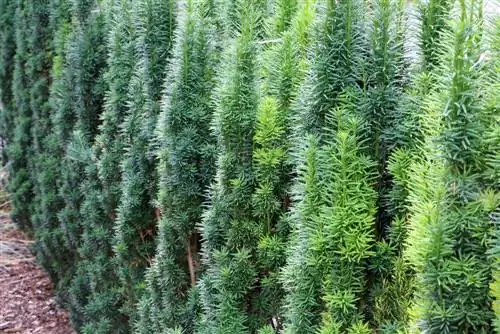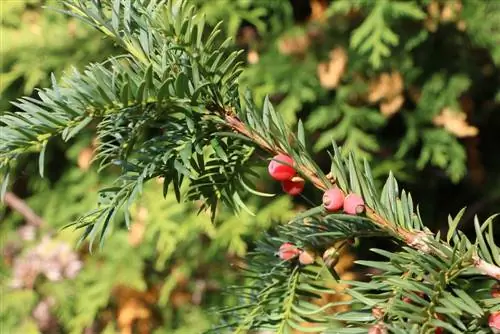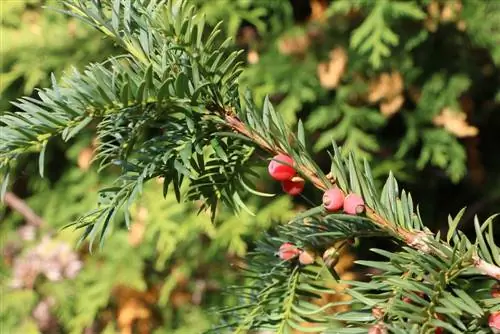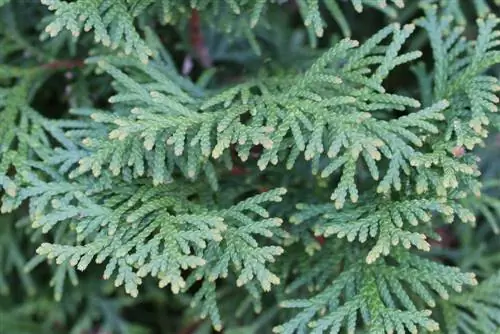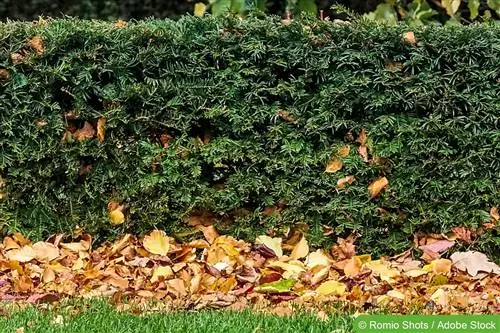- Author admin [email protected].
- Public 2023-12-17 03:39.
- Last modified 2025-01-24 12:45.
The yew combines all the good qualities that hobby gardeners want from a hedge plant. Its evergreen branches - densely covered with velvety-soft needles - easily take on any shape imaginable under the creatively wielded hedge trimmer. Thanks to its legendary pruning tolerance, it looks like it has been peeled back after every pruning. So that you can benefit from the vibrant green of a yew hedge for many years, only a few care aspects are important. The following lines reveal how exactly planting, fertilizing and cutting work.
Profile
- Plant genus: Yew (Taxus)
- Species: European yew (Taxus baccata)
- Growth height without waste up to 15 meters
- soft, sickle-shaped needles
- evergreen and hardy
- inconspicuous flowers from March to May
- dark red seed fruits in autumn
- poisonous in all parts
Yew trees can live to be several hundred years old. The famous Gardens of Versailles are living proof of the cross-generational longevity and breathtaking beauty that a yew hedge is capable of.
Location
All yew varieties score points with their exceptional shade tolerance. When young, the conifer prefers a rather dark location. Only as it gets older does a yew tree welcome full sunshine. Botanists characterize Taxus as site-vague, which very well expresses its explicit flexibility, which also affects the nature of the soil.
- sunny, partially shaded to shady location
- the higher the temperatures, the less light is required
- dry, alternately moist to moist soil
- A fresh, humus-rich, sandy-loamy garden soil is ideal
The lime content at the location plays no role for a yew hedge. From acidic to alkaline, it accepts any given pH value. Tolerance is therefore considered to be the central character trait of a yew tree in every respect. Ergo, the design plans come to the fore when choosing the location for a yew hedge.
Plants
The best time to plant a yew hedge is the weeks in late summer and early autumn. The soil is still warm, so the roots can easily establish themselves before winter sets in. Alternatively, planting the hedge in spring is an option, shortly before fresh shoots appear. While the soil is being prepared, place the root balls in water so they can soak up. Meanwhile, lean soil is enriched with compost and horn shavings. Compacted soil receives a load of sand to improve permeability. For orientation purposes, at least two cords should be tensioned to ensure that the hedge runs straight. Make sure there is an appropriate distance from the neighboring property or the street. For dense growth, plan at least three plants per linear meter. Then it continues as follows:
- Dig planting holes with twice the volume of the root ball
- lay a drainage system at the bottom, consisting of gravel, grit, gravel or pottery shards
- mix the excavated material with compost and horn shavings
- Place a potted yew tree in the middle so that the root area is flush with the ground
- press the soil, water it and protect it with a layer of mulch
Consider the high toxicity of the plant when carrying out all planting and care work. Be sure to wear gloves, long-sleeved clothing and eye protection.
Tip:
If you distribute a few nettle leaves over the drainage in the planting hole, this measure will have a beneficial effect on root growth.
Pouring
The freshly planted yew hedge requires a lot of water. Therefore, water daily and abundantly without causing waterlogging. After this somewhat critical phase has been successfully overcome, the frequency of watering is noticeably reduced.
- watering adult yew hedges during summer drought
- water a little in winter on frost-free days when there is no snow
- Rainwater is just as suitable as tap or pond water
Fertilize
The nutrient supply of a yew hedge is limited to initial fertilization in the spring before the first shoots. A dose of slow-release fertilizer is just as suitable as a generous portion of compost enriched with horn shavings. If you cultivate the hedge in a sandy location, the plants will be grateful for one or two rations of compost or horse manure during the growing season. A mulch layer of grass clippings or leaves not only keeps the soil moist and warm, but also releases additional nutrients to the yew roots.
Cutting

A densely growing, vital yew hedge sustainably underlines the prestige of the hobby gardener. The more expert the cut, the more intense the impressive look becomes. Consequently, it is worth paying appropriate attention to annual shape and maintenance pruning. A yew hedge can be shaped all year round as long as it doesn't freeze. It makes sense for experienced gardeners to choose early spring for this care measure, before the fresh needles appear. If necessary, the hedge trimmer can be used again at the end of June when a second shoot appears after St. Johannis. Pruning should be completed by mid/end of August at the latest so that the conifers have enough time to mature before the first frost. Whether you want to create an imaginative hedge work of art, or just an opaque privacy screen; Yew trees can generally tolerate cutting into old wood, so there are no limits to their creativity. The following steps apply to every cut:
- Tighten strings or build a wooden framework.
- The first step is to thin out the hedge thoroughly.
- Remove dead wood, cut off diseased, stunted branches at the base.
- Short branches that are too long until just above an outward-facing eye.
- Make each cut at an angle without squashing the shoot.
- Always keep an electric hedge trimmer parallel to the hedge.
The very compact habit of a yew hedge requires a trapezoidal shape with rounded corners. Here light and air can reach all regions so that the trees do not become bare from the inside out. A narrow top edge widens by 15-20 percent towards the base.
Observe legal requirements for rejuvenation cuts
The yew is one of the few trees that sprout again from the cane. This circumstance qualifies you as a suitable candidate for a rejuvenation cut, which is sometimes an option after 20 to 30 years. The entire hedge is cut down to just above the ground. This radical measure is not permitted at all times. The Federal Nature Conservation Act provides for a protection period from March 1st to September 30th so that breeding birds are not disturbed. A normal grooming cut is not affected by this regulation.
Conclusion
The classic yew hedge has lost none of its relevance. It still leads the undisputed ranking of the most popular hedge plants. The popularity is due to its remarkable tolerance to cutting and its undemanding nature when it comes to care. Neither planting, fertilizing nor cutting pose difficult challenges for the hobby gardener. When it comes to cultivating a yew hedge, the artistic design can be given full priority.
What you should know about the yew hedge in brief
Peculiarities
- Taxus bacatta, our native yew is an ideal hedge plant, apart from the fact that almost everything about it is poisonous.
- There are different varieties of yew, including a yellow variety: Taxus bacatta 'Washingtonii', the yellow shrub yew.
- The advantage of yew trees is that they are evergreen. They are noble and unfortunately also expensive plants.
- Yew trees get very old and grow almost everywhere. They get by with little light and barren soil.
- They can easily grow to a man's height and offer optimal privacy protection. It's good that they can also withstand the root pressure of tall trees.
- Yews are absolute survivors. They regenerate again and again from their root network, even if the trunk is destroyed or rotten.
Plants
- The planting distance of yew trees that are intended as hedge plants should be at least 60 cm.
- For slow-growing varieties, choose a slightly smaller distance.
- The location for the hedge can be sunny, partially shaded and even shady.
- The plants are happy with everything. They grow on any soil and can even cope with rocky ground.
- You loosen the soil twice as deep as the planting container is deep. The excavation will be as deep as the plant container.
- The earth does not need to be improved or enriched. When planting, you can add about a handful of primary rock powder to each planting hole.
- Otherwise you don't have to fertilize yew trees. Of course, after planting, you need to water abundantly.
- The yew tree also needs regular water in the first two years after planting. Afterwards it is so well rooted that it can take care of itself.
Care
- Yew hedges require little maintenance and are dense.
- Cutting yew hedges is no problem. They tolerate any cut, even if you cut them down to a height of 10 cm.
- They also grow out of old wood. However, after a radical cut, it takes years for the hedge to rebuild.
- A regular cut is better. The best time to prune is early spring, before budding begins.
- In principle you can cut all year round, but from March to September birds can breed in the hedge and that's why you just don't do it.
- Any outstanding new growth will be cut away and not with a roaring hedge trimmer!
- The yew tree can be propagated by cuttings. But it takes a while until it becomes a dense, high hedge.
Caution
Yew trees are poisonous in almost all parts. This is not ideal for children and pets and is especially bad for horses.

